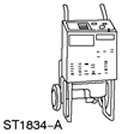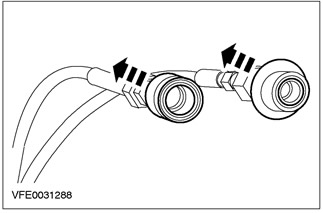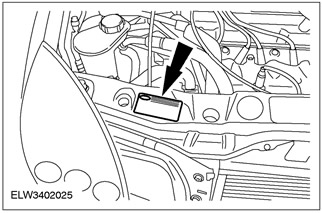Special tool
 | Service unit or equivalent equipment |
 | Refrigerant identification device or equivalent |
1.
CAUTION: The refrigerant identification equipment must be used before the system is emptied, otherwise the service unit may be damaged. The contaminated refrigerant must be disposed of as hazardous waste. Always follow the manufacturer's instructions when using service blocks.
Unscrew and remove the protective caps from the A/C system charge ports.
2. Pull back on the quick release latch on the service unit line.

3.
NOTE: Larger inner diameter is for high pressure line. The smaller inner diameter is for the low pressure line.
Connect the service block line to the A/C charge port.
4.
WARNING: Avoid releasing any form of refrigerant into the atmosphere.
NOTE: When removing air conditioning system components, calculate the remaining amount of refrigerant oil. For more information, refer to the Refilling Refrigerant Oil chapter in this section.
Drain the refrigerant from the air conditioning system through the low pressure port following the service unit manufacturer's instructions.
5.
CAUTION: To ensure proper operation of the air conditioning system, it must be evacuated for approximately 30 minutes before charging.
CAUTION: If for an extended period of time (few hours) moisture has entered the open system, replace the accumulator/water separator and increase the vacuum time to 2-3 hours.
Evacuate the air conditioning system following the service unit manufacturer's instructions.
6.
NOTE: If the air conditioning system is evacuated before the refrigerant is drained, some refrigerant will remain in the compressor cooling oil. This remaining refrigerant may evaporate, causing a slight increase (maximum two divisions) pressure gauge readings when checking for leaks. This increase in pressure does not mean that there are leaks in the air conditioning system.
NOTE: If the reading increases by more than 20 mbar (2 kPa), which means the system is leaking.
Check for leaks.
- 1. To check for leaks, close the manual valves on the gauge block, turn off the service block vacuum pump, and observe the low pressure gauge.
- 2. Using a leak detector, look for leaks in the A/C refrigerant circuit. For more information, refer to the chapter Leak detection using an electronic leak detector / Leak detection using fluorescent material available in this section.
7. Fill in cooling oil. For more information, refer to the Coolant Oil Charging chapter in this section.
CAUTION: The air conditioning system must always be evacuated before charging.
8.
NOTE: Depending on the service unit and equipment (with or without heated filling bottle) The air conditioning system can be charged with liquid refrigerant through the high pressure port or gaseous refrigerant through the low pressure port.
NOTE: The fuel capacity is indicated on a label located in the engine compartment.
Charging the air conditioning system through the high pressure port (in liquid form)
- 1. Open the shut-off valve on the high pressure side.
- 2. Switch the service unit to the mode «Fill» («Refueling») and fill the system with the prescribed amount of liquid refrigerant (R134a).

9.
CAUTION: Charging the air conditioning system through the low pressure port (only in gaseous form).
Charging the air conditioning system through the low pressure port
- 1. Open the shut-off valve on the low pressure side.
- 2. Switch the service unit to the mode «Fill» («Refueling») and fill the system with the prescribed amount of refrigerant gas (R134a).
- 3. Add the remaining refrigerant while the air conditioning is on. To do this, let the engine run at a speed of approx (1200-1500) rpm Switch the air conditioning system to maximum cooling efficiency mode and fresh air mode. Set the blower fan to maximum. Allow the system to accept the prescribed amount of refrigerant.
10.
WARNING: Do not disconnect the high pressure hose while the air conditioning system is on.
Disconnect the service unit.
- 1. Close shut-off valves.
- 2. Turn off the service unit.
- 3. Disconnect the service block line from the A/C charge port.
- 4. Screw protective caps onto filling valves.
Visitor comments